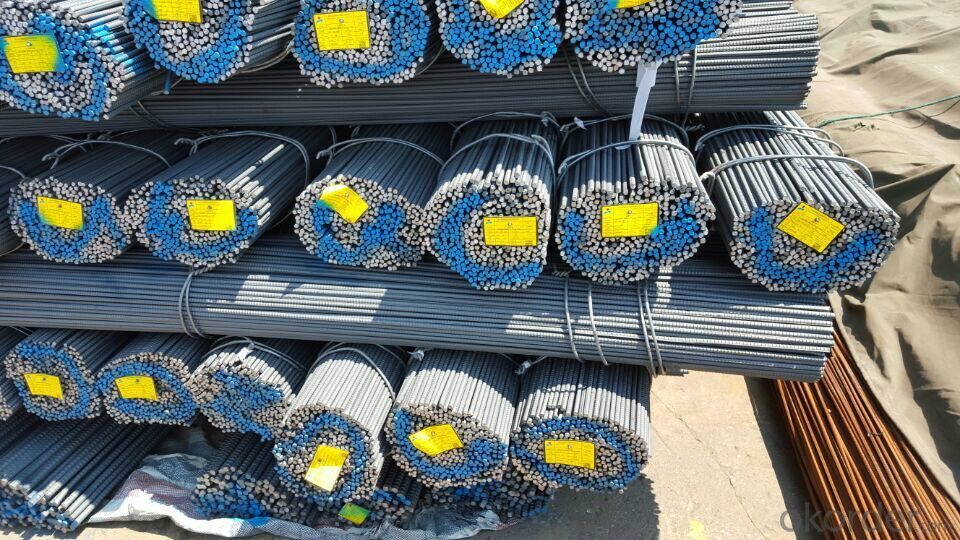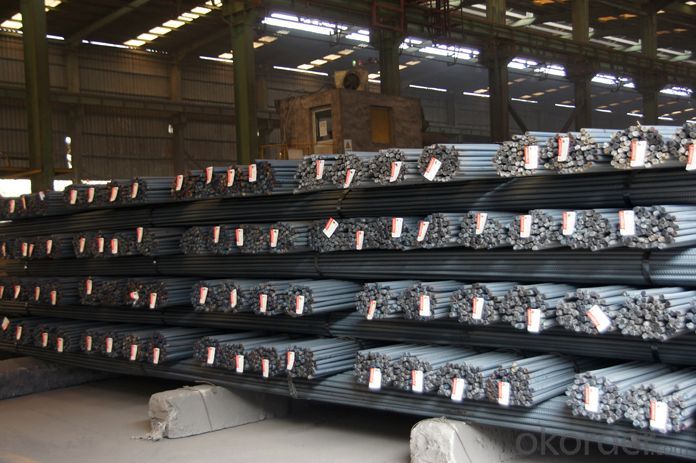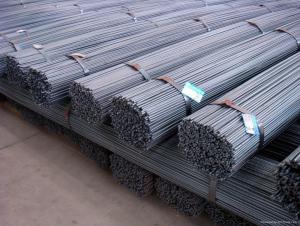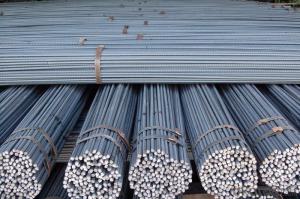Hot Rolled Deformed bars with Best Quality
- Loading Port:
- Tianjin
- Payment Terms:
- TT OR LC
- Min Order Qty:
- 25 m.t.
- Supply Capability:
- 10000 m.t./month
OKorder Service Pledge
OKorder Financial Service
You Might Also Like
OKorder is offering Deformed Steel Bar with high quality at great prices with worldwide shipping. Our supplier is a world-class manufacturer of steel, with our products utilized the world over. OKorder annually supplies products to European, North American and Asian markets. We provide quotations within 24 hours of receiving an inquiry and guarantee competitive prices.
Note:
1. Our products are produced according to national standard (GB), if not, supply according to national standards (GB) or agreement as customer required.
2. Other Grade and Standard Deformed Steel Bar we can supply:
Grade: GR40/GR60, G460B/B500A/B500B/B500C,BST500S
Standard: ASTM, BS, DIN
3. We can not only supply Deformed Steel Bar; if you need anything about building materials, please contact us for further information.
4. Please send us your detail specifications when inquire. We will reply to you as soon as possible. We sincerely hope we can establish a long stable business relationship.
Product Applications:
Deformed Steel Bar with high quality are ideal for structural applications and are widely used in the construction of buildings and bridges, and the manufacturing, petrochemical, and transportation industries.
Product Advantages:
OKorder's Deformed Steel Bar with high quality are durable, strong, and resist corrosion.
Main Product Features:
· Premium quality
· Prompt delivery & seaworthy packing (30 days after receiving deposit)
· Corrosion resistance
· Can be recycled and reused
· Mill test certification
Product Specifications:
Standard | GB | HRB400 | |
Diameter | 10mm-32mm | ||
Length | 6M, 12M | ||
Place of origin | Hebei, China mainland | ||
Advantages | exact size, regular package, chemical and mechanical properties are stable. | ||
Type | Hot rolled deformed steel bar | ||
Chemical Composition:
Grade | Technical data of the original chemical composition (%) | ||||||
C | Mn | Si | S | P | V | ||
HRB400 | ≤0.25 | ≤1.60 | ≤0.80 | ≤0.045 | ≤0.045 | 0.04-0.12 | |
Physical capability | |||||||
Yield Strength (N/cm²) | Tensile Strength (N/cm²) | Elongation (%) | |||||
≥400 | ≥570 | ≥14 | |||||
Theoretical weight and section area of each diameter as below for your information:
Diameter(mm) | Section area (mm²) | Mass(kg/m) | Weight of 12m bar(kg) |
18 | 254.5 | 2.00 | 24 |
20 | 314.2 | 2.47 | 29.64 |
22 | 380.1 | 2.98 | 35.76 |
FAQ:
Q1: Why buy Materials & Equipment from OKorder.com?
A1: All products offered by OKorder.com are carefully selected from China's most reliable manufacturing enterprises. Through its ISO certifications, OKorder.com adheres to the highest standards and a commitment to supply chain safety and customer satisfaction.
Q2: How do you guarantee the quality of our products?
A2: We have established an advanced quality management system which conducts strict quality tests at every step, from raw materials to the final product. At the same time, we provide extensive follow-up service assurances as required.
Q3: What is the normal tolerance of your steel products ?
A3: Normally 1%-3%, but we can also produce the goods according to the customers' requests
Images:


- Q:What is the difference between carbon steel and stainless steel rebars?
- Carbon steel and stainless steel rebars are both types of steel reinforcement used in construction, but they have distinct differences in composition and properties. Carbon steel rebars are made from a combination of iron and carbon, with small amounts of other elements such as manganese and copper. The carbon content in these rebars typically ranges from 0.15% to 0.60%. Carbon steel rebars are strong, durable, and cost-effective. They have good tensile strength, which is crucial for reinforcing concrete structures. However, they are susceptible to corrosion if not properly protected, especially in environments with high moisture or exposure to chemicals. On the other hand, stainless steel rebars are made from a combination of iron, chromium, nickel, and other alloying elements. The chromium content in stainless steel is typically above 10.5%, which creates a protective layer of chromium oxide on the surface of the rebar, preventing corrosion. Stainless steel rebars have excellent corrosion resistance, even in harsh environments with high humidity, saltwater, or exposure to chemicals. They are also highly durable and have high tensile strength, similar to carbon steel rebars. The main difference between carbon steel and stainless steel rebars is their corrosion resistance. Carbon steel rebars require proper protective coatings, such as epoxy or galvanization, to prevent corrosion. On the other hand, stainless steel rebars have inherent corrosion resistance due to the presence of chromium oxide layer, eliminating the need for additional coatings. Another difference is the cost. Carbon steel rebars are generally cheaper compared to stainless steel rebars. However, the total cost of a project should also consider the long-term maintenance costs associated with corrosion protection measures required for carbon steel rebars. In summary, carbon steel rebars are strong and cost-effective but require additional corrosion protection measures, while stainless steel rebars have excellent corrosion resistance and durability but come at a higher cost. The choice between the two depends on the specific project requirements, budget, and expected environmental conditions.
- Q:What is the thermal expansion coefficient of steel rebars?
- In construction projects, it is crucial to take into account the thermal expansion coefficient of steel rebars to avoid potential problems caused by temperature changes. The coefficient refers to the speed at which the rebars expand or contract. Steel is recognized for its relatively low thermal expansion coefficient, which typically measures around 12 x 10^-6 per degree Celsius. This indicates that with each degree rise in temperature, the length of the steel rebar will expand by roughly 0.000012 times its original length. By considering this factor, we can prevent issues like structural instability and cracking resulting from temperature fluctuations.
- Q:What are the guidelines for storing steel rebars on a construction site?
- When it comes to storing steel rebars on a construction site, there are several guidelines that should be followed to ensure safety and maintain the quality of the rebars. Here are some key guidelines: 1. Location: Select a designated area on the construction site that is flat, clean, and well-drained for storing the rebars. Avoid areas prone to flooding or excessive moisture. 2. Elevation: Keep the rebars off the ground by using wooden or concrete blocks to prevent direct contact with soil or water. This helps prevent rusting and corrosion. 3. Stacking: Stack the rebars in a stable manner, ensuring that they are aligned vertically and horizontally to maintain their shape and prevent any bending or warping. Use spacers or crates between layers to maintain proper spacing and prevent entanglement. 4. Protection from elements: Cover the rebars with a waterproof tarp or plastic sheet to protect them from rain, snow, or excessive sunlight. This helps prevent rusting and degradation of the rebars. 5. Separation: Store different sizes and types of rebars separately to avoid mixing or confusion during construction. Clearly label and mark each stack to identify the type, size, and grade of the rebars. 6. Accessibility: Ensure easy access to the rebars for construction workers by organizing them in a logical manner. Place smaller rebars on top for easy retrieval and avoid storing heavy rebars on top of lighter ones to prevent damage. 7. Safety precautions: Maintain a safe distance between the rebars and any heavy machinery or equipment to minimize the risk of accidents. Secure the rebars properly to prevent them from falling or causing injury. 8. Regular inspection: Regularly inspect the rebars for any signs of damage, rust, or corrosion. Replace or repair any damaged or compromised rebars to avoid compromising the structural integrity of the construction project. By adhering to these guidelines, construction sites can ensure the proper storage of steel rebars, promoting safety, efficiency, and the longevity of the rebars.
- Q:What is the role of steel rebars in ensuring structural stability?
- Steel rebars play a crucial role in ensuring structural stability in various construction projects. These reinforced bars are primarily used to strengthen concrete structures, such as buildings, bridges, and highways, by providing additional tensile strength. Concrete is a highly versatile material that can withstand compressive forces effectively. However, it has limited resistance to tensile forces. This is where steel rebars come into play. By reinforcing concrete with steel rebars, the resulting composite material can effectively resist both compressive and tensile forces, enhancing its overall structural stability. When subjected to loads, such as the weight of the structure or external forces like wind or seismic activity, the concrete experiences tensile stresses. Without reinforcement, these tensile stresses can cause cracks and ultimately lead to structural failure. Steel rebars, being highly ductile and strong in tension, can absorb and distribute these tensile forces throughout the structure. The placement and arrangement of steel rebars are carefully designed to ensure optimal reinforcement. They are typically embedded within the concrete in a grid-like pattern, forming a reinforced concrete matrix. This matrix strengthens the structure and prevents cracks from propagating, effectively increasing its load-bearing capacity and durability. Moreover, steel rebars also play a vital role in maintaining the structural integrity of concrete structures over time. They help combat the effects of shrinkage, expansion, and temperature fluctuations that can cause cracking. By providing a strong and flexible reinforcement system, steel rebars minimize the risks of structural damage and ensure the long-term stability of the construction. Overall, the role of steel rebars in ensuring structural stability can be summarized as follows: they increase the tensile strength of concrete, prevent cracks and structural failure, enhance load-bearing capacity, and promote long-term durability. By reinforcing concrete structures with steel rebars, engineers can create resilient and safe constructions that can withstand various forces and maintain their integrity for decades.
- Q:Can steel rebars be used in seismic-resistant structures?
- Seismic-resistant structures can indeed incorporate steel rebars. These rebars possess remarkable tensile strength and ductility, rendering them a perfect choice for reinforcing concrete structures in regions susceptible to earthquakes. By implementing them in a well-designed and properly installed manner, steel rebars significantly enhance the structural integrity and resilience of buildings against seismic forces. They furnish concrete with added strength and flexibility, enabling it to endure lateral and vertical loads exerted during an earthquake more effectively. Additionally, steel rebars proficiently disperse and absorb the energy generated during seismic events, thereby diminishing the risk of structural harm or collapse.
- Q:Are steel rebars suitable for use in high-temperature applications?
- High-temperature applications are generally not suitable for the use of steel rebars. Despite being a strong and durable material, steel has limitations when exposed to high temperatures. It can undergo a significant reduction in strength and even a loss of structural integrity, leading to potential failures. When subjected to high temperatures, steel goes through a process known as thermal expansion, which can weaken and deform it. This phenomenon is particularly noticeable in rebars, which are commonly used to reinforce concrete structures. The high temperatures cause the rebars to expand, exerting excessive pressure on the surrounding concrete. This pressure can result in cracks and potentially compromise the stability of the structure. Furthermore, prolonged exposure to high temperatures can cause a loss of the steel's mechanical properties, including its tensile strength and load-bearing capacity. As a result, the rebars become less effective in resisting external forces and reinforcing the concrete. For this reason, it is generally recommended to consider alternative materials, such as stainless steel or special alloys, for high-temperature applications. These materials are specifically designed to withstand elevated temperatures without compromising their structural integrity. To ensure safety and structural stability, it is important to consult with experts and engineers who are familiar with high-temperature applications in order to determine the most suitable materials for specific projects.
- Q:Can steel rebars be used in water treatment plant construction?
- Yes, steel rebars can be used in water treatment plant construction. Steel rebars are commonly used in the construction of various structures, including water treatment plants, due to their high strength and durability. They provide reinforcement to concrete structures and ensure their integrity and longevity, making them suitable for use in water treatment plant construction.
- Q:Can steel rebars be used in structures with high resistance to fatigue?
- Structures with high resistance to fatigue can utilize steel rebars. These rebars are commonly employed as reinforcement in concrete structures due to their durability and high tensile strength. They enhance the strength and support of the concrete, making it more resilient against various loads and stresses, including fatigue. Fatigue occurs when a material weakens due to repeated stress cycles, potentially causing structural failure over time. Steel rebars, particularly those made from high-strength steel, are specifically designed to withstand cyclic loading and offer exceptional resistance to fatigue. With their high fatigue strength, they can endure multiple stress cycles without significant deterioration. In structures with high fatigue resistance, engineers strategically position steel rebars to distribute and dissipate applied loads. This reduces stress concentrations and minimizes the risk of fatigue failure. The reinforcement provided by steel rebars improves the overall structural integrity and longevity of the construction. Furthermore, the use of steel rebars allows for the implementation of various design techniques, including the inclusion of additional reinforcing elements like stirrups and tie hooks. These elements further enhance the structure's resistance to fatigue. By considering these design considerations, steel rebars effectively mitigate the effects of cyclic loading and maintain the structure's stability and performance over time. However, it is important to note that the fatigue resistance of a structure does not solely rely on steel rebars. Other factors, such as the quality of concrete, proper detailing and placement of rebars, and adherence to proper construction practices, also impact the overall fatigue performance. Therefore, it is crucial to adopt a comprehensive approach that incorporates appropriate design, material selection, and construction techniques to achieve structures with high resistance to fatigue.
- Q:How do steel rebars contribute to the structural integrity of a building?
- Steel rebars play a crucial role in enhancing the structural integrity of a building. These reinforcing bars, commonly known as rebars, are typically made from steel and are used to provide strength and stability to concrete structures. They are embedded within the concrete to create a composite material that can withstand various types of forces and loads. Firstly, rebars help to distribute and transfer loads throughout the structure. When a building is subjected to external forces such as wind, earthquakes, or heavy loads, the rebars act as a reinforcement by absorbing and dispersing these forces. By distributing the load over a larger area, they prevent concentrated stress points that could potentially lead to structural failure. Secondly, rebars assist in preventing cracks and fractures in the concrete. Concrete, although highly durable in compression, is weak in tension. Steel rebars, with their high tensile strength, counteract this weakness by resisting the tensile forces that may cause the concrete to crack or fail. By reinforcing the concrete, rebars ensure that the structure remains intact and can withstand various types of stresses. Moreover, rebars increase the overall durability and lifespan of a building. By providing additional strength and stability, they reduce the likelihood of structural damage, ensuring that the building can withstand the test of time. This is particularly important in areas prone to natural disasters, where the strength of a building can be a matter of life and death. Lastly, steel rebars contribute to the overall safety of a building. By reinforcing the structure, they increase its ability to withstand extreme events such as earthquakes or heavy impacts. This not only protects the occupants of the building but also reduces the risk of collateral damage to surrounding structures. In conclusion, steel rebars are essential components in construction that significantly contribute to the structural integrity of a building. Their ability to distribute loads, prevent cracks, increase durability, and enhance safety make them an indispensable element in modern construction practices.
- Q:Are steel rebars resistant to chemical attacks?
- Yes, steel rebars are generally resistant to chemical attacks. The high strength and durability of steel make it less susceptible to damage from various chemicals, including acids and alkalis. However, certain aggressive chemicals or environments may cause corrosion over time, which can be mitigated by applying protective coatings or using corrosion-resistant alloys.
1. Manufacturer Overview |
|
|---|---|
| Location | |
| Year Established | |
| Annual Output Value | |
| Main Markets | |
| Company Certifications | |
2. Manufacturer Certificates |
|
|---|---|
| a) Certification Name | |
| Range | |
| Reference | |
| Validity Period | |
3. Manufacturer Capability |
|
|---|---|
| a)Trade Capacity | |
| Nearest Port | |
| Export Percentage | |
| No.of Employees in Trade Department | |
| Language Spoken: | |
| b)Factory Information | |
| Factory Size: | |
| No. of Production Lines | |
| Contract Manufacturing | |
| Product Price Range | |
Send your message to us
Hot Rolled Deformed bars with Best Quality
- Loading Port:
- Tianjin
- Payment Terms:
- TT OR LC
- Min Order Qty:
- 25 m.t.
- Supply Capability:
- 10000 m.t./month
OKorder Service Pledge
OKorder Financial Service
Similar products
New products
Hot products
Related keywords





























